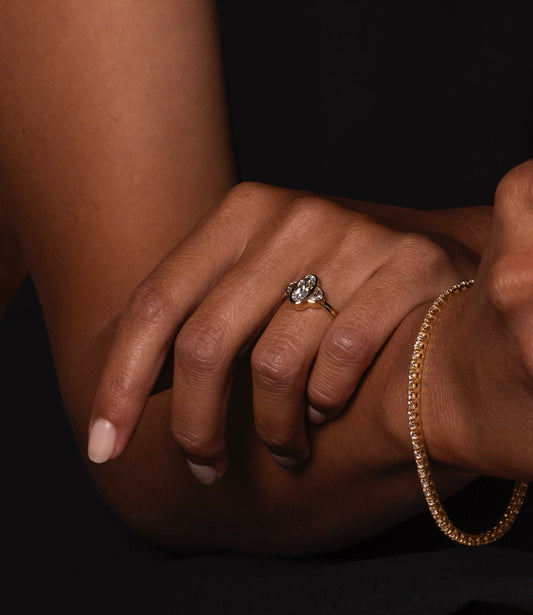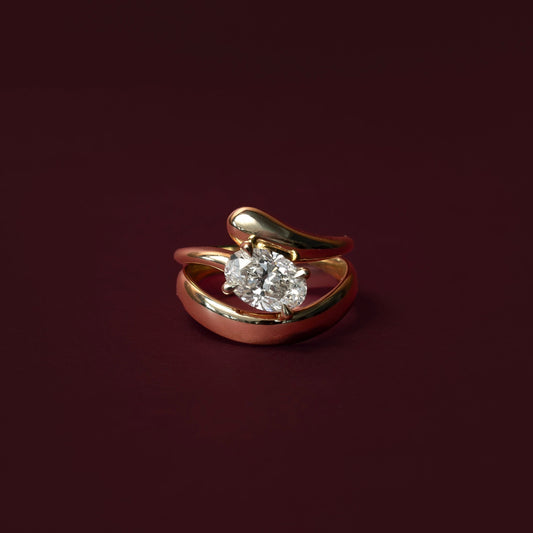What is a Lab-Grown Diamond?
How Are Lab Grown Gemstones Made?
Ethically Sourced
Lab grown gemstones are created in controlled laboratory environments, which can have positive environmental and social impacts.
High-Quality
Lab grown gemstones are carefully manufactured under controlled conditions, allowing for precise control over their color, clarity, and overall quality.
Affordable
With lab grown gems, you can often get larger or higher-quality stones at a fraction of the price of their natural counterparts.
Moissanite vs Lab Grown Diamond
Compare the key properties and characteristics
| Property | Moissanite | Lab Grown Diamond |
|---|---|---|
| Durability | Moissanites are slightly softer at 9.25 on the Mohs scale, but still extremely durable and suitable for everyday use. | Lab diamonds score 10 on the Mohs scale, making them the hardest and most durable gemstone suitable for daily wear. |
| Brilliance | Higher refractive index of 2.64 to 2.69, making them more brilliant and fiery. Larger stones may display more rainbow-like flashes. | Refractive index of 2.417 to 2.419, giving off a classic, balanced sparkle (brilliance, fire, and scintillation) similar to mined diamonds. |
| Color | Typically colorless or near-colorless, but available in custom shades like teal, grey, green, yellow, and black. | Can be grown in colorless grades (D–Z) or fancy colors (blue, pink, yellow, etc.). Rare colors are more affordable than natural diamonds. |
| Price | Most affordable of the three (natural, lab diamond, moissanite). Price varies by size, shape, and color grade, but overall significantly cheaper. | Costs less than natural diamonds, but more than moissanite. Price is determined by the 4Cs (cut, clarity, color, carat) and shape. |
| Sourcing | Lab-created using different methods, specifically developed as an alternative to diamonds. Also cut and polished into jewelry-ready gems. | Grown in high-tech labs using HPHT (High Pressure High Temperature) or CVD (Chemical Vapor Deposition). Cut and polished like mined diamonds. |
| Fire | Displays more fire (rainbow flashes) than diamonds, especially noticeable in larger stones. | Moderate fire — provides a balanced rainbow and white light return, mimicking a natural diamond’s sparkle. |
| Scintillation | More intense and dramatic scintillation, sometimes seen as too “flashy” or “disco-ball like” by diamond purists. | Natural-looking scintillation (sparkle when moving), very similar to mined diamonds. |
| Weight | Moissanite is lighter than a diamond. A 1 carat moissanite is smaller in weight (~0.88 ct) but equal in size due to lower density. | Slightly heavier than moissanite. A 1 carat diamond weighs exactly 1.00 ct. |
Frequently Asked Questions
What is a lab-grown diamond certification?
A lab-grown diamond certificate is a document that provides important information about a lab-grown diamond. It serves as an official record that verifies the authenticity, quality, and characteristics of the diamond created in a laboratory environment rather than being mined naturally from the Earth.
Do lab-grown diamonds hold value?
Lab-grown diamonds are relatively new on the market, so there’s not a lot of historical data about their value. Unlike natural diamonds, they don’t have a track record of maintaining or increasing in value. That said, they’re a great option if you want to get a larger diamond for your budget.
Do lab-grown diamonds dull or yellow over time?
No, just like natural diamonds, lab-grown diamonds do not dull or yellow over time. That said, you’ll want to get regular cleanings to keep that sparkle.
How long do lab-grown diamonds last?
Lab-grown diamonds last forever, and can be passed down from generation to generation just like natural diamonds.
Are lab-grown diamonds real?
Yes! Lab-grown diamonds have the same chemical makeup as natural diamonds, only they’re made over weeks using advanced science and technology.
Do lab-grown diamonds look cheap?
To the naked eye lab-grown diamonds look no different than natural diamonds. In fact, you can usually get a larger lab-grown diamond for your budget. So lab-grown diamonds might actually look more expensive, when really they’re not.
Are lab-grown diamonds tacky?
This is a subjective question, but obviously we think the answer is no. Diamonds are a classic, versatile, gorgeous gemstone that can be passed down for generations, even if they’re lab-grown.
Are lab-grown diamonds worth anything?
Prices and resale values may go down as manufacturing efficiencies continue but sentimental and personal value will never fade.











